A Study on the Multifunctional Properties and Application Perspectives of ZnO/SiC Composite Materials
Abstract
1. Introduction
2. Materials Synthesis Methods
2.1. Sol–Gel Methods
2.2. Chemical Vapor Deposition (CVD)
2.3. Mechanical Processing via Bead Milling
2.4. Hydrothermal Synthesis
2.5. E-Beam and Thermal Evaporation
2.6. Radio Frequency (RF) Magnetron Co-Sputtering
3. Properties of ZnO/SiC Composites
3.1. Optical Properties
3.2. Electrical Properties
3.3. Thermal Stability
3.4. Mechanical/Structural Properties
3.5. Interfacial Properties
4. Application Perspectives
4.1. Photocatalysis
4.2. Optoelectronic Devices
4.3. Potential Applications in Photovoltaics, High-Temperature Electronics, and Sensing Technologies
5. Challenges and Future Perspectives
- Synthesis Complexity: achieving uniform dispersion and phase compatibility remains a challenge.
- Cost of Production: advanced synthesis methods like CVD are expensive and may limit large-scale production.
- Stability Issues: long-term stability under operational conditions needs further research.
6. Conclusions
Funding
Data Availability Statement
Acknowledgments
Conflicts of Interest
References
- Cuadra, J.G.; Estrada, A.C.; Oliveira, C.; Abderrahim, L.A.; Porcar, S.; Fraga, D.; Trindade, T.; Seabra, M.P.; Labrincha, J.; Carda, J.B. Functional properties of transparent ZnO thin films synthesized by using spray pyrolysis for environmental and biomedical applications. Ceram. Int. 2023, 49, 32779–32788. [Google Scholar] [CrossRef]
- Kumar, V.; Prakash, J.; Pathak, D.; Sharma, D.P.; Purohit, L.P.; Swart, H.C. Ion beam engineering of implanted ZnO thin films for solar cell and lighting applications. Chem. Eng. J. Adv. 2023, 15, 100501. [Google Scholar] [CrossRef]
- Petrov, V.V.; Sysoev, V.V.; Ignatieva, I.O.; Gulyaeva, I.A.; Volkova, M.G.; Ivanishcheva, A.P.; Khubezhov, S.A.; Varzarev, Y.N.; Bayan, E.M. Nanocomposite Co3O4-ZnO Thin Films for Photoconductivity Sensors. Sensors 2023, 23, 5617. [Google Scholar] [CrossRef] [PubMed]
- Krysova, H.; Mansfeldova, V.; Tarabkova, H.; Pisarikova, A.; Hubicka, Z.; Kavan, L. High-quality dense ZnO thin films: Work function and photo/electrochemical properties. J. Solid State Electrochem. 2024, 28, 2531–2546. [Google Scholar] [CrossRef]
- Gartner, M.; Stroescu, H.; Mitrea, D.; Nicolescu, M. Various Applications of ZnO Thin Films Obtained by Chemical Routes in the Last Decade. Molecules 2023, 28, 4674. [Google Scholar] [CrossRef]
- Toma, M.; Domokos, R.; Lung, C.; Marconi, D.; Pop, M. Characterization of ZnO, Ga-Doped ZnO, and Nd-Ga-Doped ZnO Thin Films Synthesized by Radiofrequency Magnetron Sputtering. Anal. Lett. 2023, 57, 797–811. [Google Scholar] [CrossRef]
- Petrov, V.V.; Ignatieva, I.O.; Volkova, M.G.; Gulyaeva, I.A.; Pankov, I.V.; Bayan, E.M. Polycrystalline Transparent Al-Doped ZnO Thin Films for Photosensitivity and Optoelectronic Applications. Nanomaterials 2023, 13, 2348. [Google Scholar] [CrossRef]
- Uzar, N.; Abdulaziz, U.; Erbas, O.G.; Aydin, M.; Dolgun, M.F. Enhancement of structural, optical, electrical, optoelectronic and thermoelectric properties of ZnO thin film via Ni doping and Ni-B co-doping. Phys. Scr. 2024, 99, 075995. [Google Scholar] [CrossRef]
- Nur-E-Alam, M.; Ferdaous, M.T.; Alghafis, A.; Vasiliev, M.; Yap, B.K.; Kiong, T.S.; Sapeli, M.M.I.; Amin, N.; Ibrahim, M.A.; Bin Rafiq, M.K.S. Tailoring Ga-Doped ZnO Thin Film Properties for Enhanced Optoelectric Device Performance: Argon Flow Rate Modulation and Dynamic Sputtering Geometry Analysis. Sol. RRL 2025, 9, 2400353. [Google Scholar] [CrossRef]
- Al-Maamori, M.H.; Al-Jamal, A.N.; Habeeb, S.A.; Hassan, A.S.; Majdi, H.S. Al3+-modified ZnO thin film sensor fabricated by the sputtering method: Characterization and a carbon monoxide gas detection study. J. Chem. Res. 2024, 48, 17475198231221453. [Google Scholar] [CrossRef]
- Sharma, H.; Kumar, S.; Yadav, J.; Prasad, J.; Singh, M. Effect of Sn-incorporation on the Structural and Optical Properties of ZnO Thin Films Prepared by Sol-Gel Method. Orient. J. Chem. 2023, 39, 1540–1546. [Google Scholar] [CrossRef]
- Vyas, S. A short review on properties of and applications of Zinc Oxide based thin films and devices. Johns. Matthey Technol. Rev. 2020, 64, 202–218. [Google Scholar] [CrossRef]
- Vagena, I.-A.; Gatou, M.-A.; Theocharous, G.; Pantelis, P.; Gazouli, M.; Pippa, N.; Gorgoulis, V.G.; Pavlatou, E.A.; Lagopati, N. Functionalized ZnO-Based Nanocomposites for Diverse Biological Applications: Current Trends and Future Perspectives. Nanomaterials 2024, 14, 397. [Google Scholar] [CrossRef] [PubMed]
- Oloruntoba, S.O.; Zainal, Z.; Sulaiman, Y.; Zawawi, R.M. Fabrication of Zinc Oxide thin films by Sol-Gel dip coating process. J. Nanosci. Res. Rep. 2024, 6, 1–6. [Google Scholar] [CrossRef]
- Gonzalez Cuadra, J.; Lahlahi, A.; Porcar, S.; Cadena, R.; Toca, S.; Fraga, D.; Carda, J. Zinc Oxide Thin Films: Synthesis and Photocatalytic Applications; IntechOpen: London, UK, 2024. [Google Scholar] [CrossRef]
- Dawka, S.; Duan, P.; Maitra, S.; Sapkota, R.; Papadopoulos, C. Solution-Processed Zinc Oxide Nanoparticles for Thin Film Optoelectronic Neuromorphic Devices. Meet. Abstr. 2024, MA2024-02, 2531. [Google Scholar] [CrossRef]
- Clancy, M. How Silicon Carbide Thin Films Are Revolutionizing Power Electronics. Available online: https://korvustech.com/silicon-carbide-thin-films/ (accessed on 4 March 2025).
- Chaussende, D.; Tabouret, V.; Crisci, A.; Morais, M.; Coindeau, S.; Berthomé, G.; Kollmuss, M.; Wellmann, P.; Jomard, F.; Pinault-Thaury, M.-A.; et al. Investigation of amorphous-SiC thin film deposition by RF magnetron sputtering for optical applications. Mater. Sci. Semicond. Process. 2024, 182, 108673. [Google Scholar] [CrossRef]
- Xu, M.; Shin, D.; Sberna, P.M.; van der Kolk, R.; Cupertino, A.; Bessa, M.A.; Norte, R.A. High-Strength Amorphous Silicon Carbide for Nanomechanics. Adv. Mater. 2024, 36, 2306513. [Google Scholar] [CrossRef]
- Kaloyeros, A.E.; Arkles, B. Silicon Carbide Thin Film Technologies: Recent Advances in Processing, Properties, and Applications—Part I Thermal and Plasma CVD. ECS J. Solid State Sci. Technol. 2023, 12, 103001. [Google Scholar] [CrossRef]
- Lopez-Rodriguez, B.; van der Kolk, R.; Aggarwal, S.; Naresh, S.; Li, Z.; van der Plaats, D.; Scholte, T.; Chang, J.; Gröblacher, S.; Pereira, S.F.; et al. High-Quality Amorphous Silicon carbide for hybrid photonic integration deposited at a low temperature. ACS Photonics 2023, 10, 3748–3754. [Google Scholar] [CrossRef]
- Greenhorn, S.; Bano, E.; Stambouli, V.; Zekentes, K. Amorphous SiC Thin Films Deposited by Plasma-Enhanced Chemical Vapor Deposition for Passivation in Biomedical Devices. Materials 2024, 17, 1135. [Google Scholar] [CrossRef]
- Krupa, M.M. Silicon carbide films as protective and optical coatings. Int. J. Chem. Eng. Mater. 2024, 3, 55–58. [Google Scholar] [CrossRef]
- Shah, A. Chapter IC-1—Thin-Film Silicon Solar Cells1. In Solar Cells, 2nd ed.; McEvoy, A., Castañer, L., Markvart, T., Eds.; Elsevier: Amsterdam, The Netherlands, 2013; pp. 159–223. ISBN 9780123869647. [Google Scholar] [CrossRef]
- EKaloyeros, A.; Arkles, B. Silicon Carbide Thin Films: Innovations in Property, Process, and Applications; IntechOpen: London, UK, 2025. [Google Scholar] [CrossRef]
- Trzepieciński, T.; Batu, T.; Kibrete, F.; Lemu, H.G. Application of Composite Materials for Energy Generation Devices. J. Compos. Sci. 2023, 7, 55. [Google Scholar] [CrossRef]
- Ince, J.C.; Peerzada, M.; Mathews, L.D.; Pai, A.R.; Al-qatatsheh, A.; Abbasi, S.; Yin, Y.; Hameed, N.; Duffy, A.R.; Lau, A.K.; et al. Overview of emerging hybrid and composite materials for space applications. Adv. Compos. Hybrid Mater. 2023, 6, 130. [Google Scholar] [CrossRef]
- Nur-E-Alam, M.; Basher, M.K.; Vasiliev, M.; Das, N. Physical Vapor-Deposited Silver (Ag)-Based Metal-Dielectric Nanocomposites for Thin-Film and Coating Applications. Appl. Sci. 2021, 11, 6746. [Google Scholar] [CrossRef]
- Nur-E-Alam, M.; Yap, B.K.; Basher, M.K.; Islam, M.A.; Hossain, M.K.; Soudagar, M.E.M.; Das, N.; Vasiliev, M.; Kiong, T.S. Multifunctional Prospects of Physical Vapor-Deposited Silver-Based Metal-Dielectric Nanocomposite Thin Films. J. Sci. Adv. Mater. Devices 2025, 10, 100871. [Google Scholar] [CrossRef]
- El-Fattah, H.A. Effect of surface morphology on optical properties of two multilayer structures CuO/ZnO/SiC and Al2O3/ZnO/SiC. Sci. Rep. 2023, 13, 23035. [Google Scholar] [CrossRef]
- Mosabbir, A.S.M.; Sadek, M.S.; Mahmood, M.; Sultan, S.M.; Alshammari, F.; Alobaid, M.; Alghafis, A.A.; Ibrahim, M.A.; Sobayel, K. Exploration of ZnO:SiC composite material for photovoltaic applications. Interactions 2025, 246, 7. [Google Scholar] [CrossRef]
- GMeenakshi, A. Sivasamy, Nanorod ZnO/SiC nanocomposite: An efficient catalyst for the degradation of an endocrine disruptor under UV and visible light irradiations. J. Environ. Chem. Eng. 2018, 6, 3757–3769. [Google Scholar] [CrossRef]
- Zhang, J.; Cui, Y.; Lin, Y.; Tang, Y.; Yu, Y.; Yan, S.; Gao, B.; Hu, G.; Chu, P.K. Facile fabrication of SiC/ZnO composite and its enhanced sensitivity for detection of NO. AIP Adv. 2023, 13, 105218. [Google Scholar] [CrossRef]
- Bokov, D.; Turki Jalil, A.; Chupradit, S.; Suksatan, W.; Javed Ansari, M.; Shewael, I.H.; Valiev, G.H.; Kianfar, E. Nanomaterial by Sol-Gel Method: Synthesis and Applicatio. Adv. Mater. Sci. Eng. 2021, 2021, 5102014. [Google Scholar] [CrossRef]
- Potter, D.B.; Powell, M.J.; Darr, J.A.; Parkin, I.P.; Carmalt, C.J. Transparent conducting oxide thin films of Si-doped ZnO prepared by aerosol assisted CVD. RSC Adv. 2017, 7, 10806–10814. [Google Scholar] [CrossRef]
- Nakano, T.; Tanehira, T.; Ishitani, K.; Nakao, M. Growth of ZnO Epitaxial Films Using 3C-SiC Substrate with Buried Insulating Layer. Jpn. J. Appl. Phys. 2009, 48, 041106. [Google Scholar] [CrossRef]
- Ashrafi, A.B.M.A.; Zhang, B.-P.; Binh, N.T.; Wakatsuki, K.; Segawa, Y. High-Quality ZnO Layers Grown on 6H-SiC Substrates by Metalorganic Chemical Vapor Deposition. Jpn. J. Appl. Phys. 2004, 43, 1114. [Google Scholar] [CrossRef]
- Shtepliuk, I.; Khranovskyy, V.; Ievtushenko, A.; Yakimova, R. Temperature-Dependent Photoluminescence of ZnO Thin Films Grown on Off-Axis SiC Substrates by APMOCVD. Materials 2021, 14, 1035. [Google Scholar] [CrossRef]
- Lim, T. Nanoengineering of ZnO Electrical and Optical Characteristics by Controlling Its Morphology and Defects via Reaction Kinetics, Fluid Dynamics, and Stoichiometry in Low-Pressure CVD Synthesis. Ph.D. Thesis, University of California, Riverside, CA, USA, 2016. Available online: https://escholarship.org/uc/item/9s12n1kf (accessed on 28 April 2025).
- Bekermann, D.; Gasparotto, A.; Barreca, D.; Bovo, L.; Devi, A.; Fischer, R.A.; Lebedev, O.I.; Maccato, C.; Tondello, E.; Tendeloo, G.V. Highly Oriented ZnO Nanorod Arrays by a Novel Plasma Chemical Vapor Deposition Process. Cryst. Growth Des. 2010, 10, 2011–2018. [Google Scholar] [CrossRef]
- Sánchez-Martín, S.; Olaizola, S.M.; Castaño, E.; Urionabarrenetxea, E.; Mandayo, G.G.; Ayerdi, I. Study of deposition parameters and growth kinetics of ZnO deposited by aerosol assisted chemical vapor deposition. RSC Adv. 2021, 11, 18493–18499. [Google Scholar] [CrossRef]
- Ahmmad, B.; Kanomata, K.; Hirose, F. Controlled Morphologies of Nanostructured ZnO Films by MOCVD Method. Appl. Mech. Mater. 2014, 492, 311–315. [Google Scholar] [CrossRef]
- Sabzi, M.; Mousavi Anijdan, S.H.; Shamsodin, M.; Farzam, M.; Hojjati-Najafabadi, A.; Feng, P.; Park, N.; Lee, U. A Review on Sustainable Manufacturing of Ceramic-Based Thin Films by Chemical Vapor Deposition (CVD): Reactions Kinetics and the Deposition Mechanisms. Coatings 2023, 13, 188. [Google Scholar] [CrossRef]
- Cao, K.; Li, H.; Xia, S.; Liu, H.; Yang, T.; Zheng, Y.; Wang, J.; Zhang, B.; Li, H. A batch preparation of large-size graphite plate/SiC coating by CVD: CFD simulation and experimental. Ceram. Int. 2024, 50, 16798–16812. [Google Scholar] [CrossRef]
- Xu, J.; Tian, H.J.; Tian, Y.J.; Wen, H. Fabrication of Micro-Structural ZnO Crystal and the Concentration Fields of the CVD Reactor. Adv. Mater. Res. 2013, 750–752, 352–357. [Google Scholar] [CrossRef]
- Ali, W.A.; Richards, S.E.; Alzard, R.H. Unlocking the potential of ball milling for nanomaterial Synthesis: An overview. J. Ind. Eng. Chem. 2025, 149, 63–93. [Google Scholar] [CrossRef]
- Erdemir, F.; Varol, T. and Çanakçı, A. Synthesis of SiC nanoparticles by central composite design response surface methodology directed mechanical milling. Micro Nano Lett. 2020, 15, 187–190. [Google Scholar] [CrossRef]
- Jasim, A.H.; Joudi, W.M.; Radhi, N.S.; Saud, A.N. Mechanical properties and wear characteristics of (Aluminum-Zinc Oxide) metal matrix composite prepared using Stir casting process. Mater. Sci. Forum 2020, 1002, 175–184. [Google Scholar] [CrossRef]
- Arora, S.; Srivastava, C. Synthesis of ZnO Nanocrystal–Graphene Composite by Mechanical Milling and Sonication-Assisted Exfoliation. JOM 2017, 69, 1021–1026. [Google Scholar] [CrossRef]
- Abduev, A.K.; Akhmedov, A.K.; Asvarov, A.S.; Rabadanov, K.S.; Emirov, R.M. Formation of a ZnO–C Composite with a Nanocrystalline Structure. Tech. Phys. 2019, 64, 666–673. [Google Scholar] [CrossRef]
- Gençyılmaz, O. Hydrothermal synthesis of ZnO films and characterization. Anadolu Univ. J. Sci. Technol. A—Appl. Sci. Eng. 2016, 17, 660–669. [Google Scholar] [CrossRef]
- Lien, W.-C.; Tsai, D.-S.; Chiu, S.H.; Senesky, D.G.; Maboudian, R.; Pisano, A.P.; He, J.H. Low-Temperature, Ion Beam-Assisted SiC Thin Films with Antireflective ZnO Nanorod Arrays for High-Temperature Photodetection. IEEE Electron Device Lett. 2011, 32, 1564–1566. [Google Scholar] [CrossRef]
- Ma, H.C.; Yuan, S.Y.; Fu, Y.H.; Dong, X.L.; Zhang, X.F.; Ma, C.; Zhang, X.X. Hydrothermal Synthesis of ZnO/Zn Composites with Enhanced Photocatalytic Performance. Adv. Mater. Res. 2012, 518–523, 746–749. [Google Scholar] [CrossRef]
- Gupta, M.K.; Kumar, Y.; Sonnathi, N.; Sharma, S.K. Hydrothermally Grown Zinc Oxide Nanostructures@Carbon Composites for Supercapacitor Application. Phys. Status Solidi A 2023, 220, 2200451. [Google Scholar] [CrossRef]
- El-Shafey, H.M.; Saif, M.; Aly, M.H.; Hafez, H.S. Enhancing the Photo and Biomedical Activity of ZnO by Incorporation with Zinc Silicate Nanocomposites. Appl. Organomet. Chem. 2020, 34, e5902. [Google Scholar] [CrossRef]
- Felix, J.F.; Aziz, M.; de Araujo, C.I.L.; de Azevedo, W.M.; Anjos, V.; da Silva, E.F.; Henini, M. Zinc oxide thin films on silicon carbide substrates (ZnO/SiC): Electro-optical properties and electrically active defects. Semicond. Sci. Technol. 2014, 29, 045021. [Google Scholar] [CrossRef]
- Fu, Z. ZnO/SiC/Si Heterojunction Solar Battery and Preparation Method Thereof. 2012. Available online: https://patents.google.com/patent/CN101694853B/en (accessed on 29 April 2025).
- Daniel, A.; Belmonte, T. Synthesis of Si—Zn—O Composite Thin Films by a Hybrid PECVD-PVD Radiofrequency Process. Plasma Process. Polym. 2007, 4, S664–S667. [Google Scholar] [CrossRef]
- Duan, L.; Yang, Z.; Xia, Y.; Dai, X.; Wu, J.; Sun, M. ZnO-decorated SiC@C hybrids with strong electromagnetic absorption. Beilstein J. Nanotechnol. 2023, 14, 565–573. [Google Scholar] [CrossRef]
- Alam, M.N.-E.; Vasiliev, M.; Alameh, K. High-performance RF-sputtered Bi-substituted iron garnet thin films with almost in-plane magnetization. Opt. Mater. Express 2017, 7, 676–686. [Google Scholar] [CrossRef]
- Nur-E-Alam, M.; Vasiliev, M.; Alameh, K. Bi-Substituted Ferrite Garnet Type Magneto-Optic Materials Studied at ESRI Nano-Fabrication Laboratories, ECU, Australia. Coatings 2022, 12, 1471. [Google Scholar] [CrossRef]
- Choudhary, S.; Sharma, V.; Sharma, A.; Kumar, A.; Kumar, P. Analyzing the Properties of Zinc Oxide (ZnO) Thin Film Grown on Silicon (Si) Substrate, ZnO/Si Using RF Magnetron Sputtering Approach. In Modeling, Characterization, and Processing of Smart Materials; Kumar, A., Kumar, P., Srivastava, A., Goyat, V., Eds.; IGI Global Scientific Publishing: Hershey, PA, USA, 2023; pp. 297–308. [Google Scholar] [CrossRef]
- Li, Q.; Fu, S.; Song, C.; Wang, G.; Zeng, F.; Pan, F. Sputtering power dependence of structure and photoluminescence of ZnO on 6H–SiC. J. Mater. Sci. Mater. Electron. 2017, 28, 17881–17888. [Google Scholar] [CrossRef]
- Nomoto, J.-i.; Miyata, T.; Minami, T. Transparent conducting Si-codoped Al-doped ZnO thin films prepared by magnetron sputtering using Al-doped ZnO powder targets containing SiC. J. Vac. Sci. Technol. A 2009, 27, 1001–1005. [Google Scholar] [CrossRef]
- Al-Bataineh, Q.M.; Telfah, M.; Ahmad, A.A.; Alsaad, A.M.; Qattan, I.A.; Baaziz, H.; Charifi, Z.; Telfah, A. Synthesis, Crystallography, Microstructure, Crystal Defects, Optical and Optoelectronic Properties of ZnO:CeO2 Mixed Oxide Thin Films. Photonics 2020, 7, 112. [Google Scholar] [CrossRef]
- Taube, A.; Sochacki, M.; Kwietniewski, N.; Werbowy, A.; Gierałtowska, S.; Wachnicki, L.; Godlewski, M.; Szmidt, J. Electrical properties of isotype and anisotype ZnO/4H-SiC heterojunction diodes. Appl. Phys. Lett. 2017, 110, 143509. [Google Scholar] [CrossRef]
- Chen, Y.; Saraf, G.; Reyes, P.I.; Duan, Z.; Zhong, J.; Lu, Y. Structural, electrical, and piezoelectric properties of ZnO films on Si C-6 H substrates. J. Vac. Sci. Technol. B 2009, 27, 1631. [Google Scholar] [CrossRef]
- Alivov, Y.I.; Johnstone, D.; Özgür, U.; Avrutin, V.; Fan, Q.; Akarca-Biyikli, S.S.; Morkoç, H. Electrical and Optical Properties of n-ZnO/p-SiC Heterojunctions. Jpn. J. Appl. Phys. 2005, 44, 7281–7284. [Google Scholar] [CrossRef]
- Platonov, V.B.; Rumyantseva, M.N.; Frolov, A.S.; Yapryntsev, A.D.; Gaskov, A.M. High-temperature resistive gas sensors based on ZnO/SiC nanocomposites. Beilstein J. Nanotechnol. 2019, 10, 1537–1547. [Google Scholar] [CrossRef] [PubMed]
- Krishnasamy, E.; Iyyanar, S.; Munusamy, V.; Priya, S.D.; Fallah, M.H.; Singh, K. Study on the effect of ZnO nanoparticles embedded ramie fiber reinforced epoxy matrix composite—A novel material for sustainable development. E3S Web Conf. 2024, 588, 01017. [Google Scholar] [CrossRef]
- Raja, T.; Devarajan, Y.; Kailiappan, N. Study on enhancing mechanical and thermal properties of carbon fiber reinforced epoxy composite through zinc oxide nanofiller. Discov. Appl. Sci. 2024, 6, 566. [Google Scholar] [CrossRef]
- Badini, C.; Fino, P.; Ubertalli, G.; Taricco, F. Degradation at 1200 °C of a SiC coated 2D-Nicalon/C/SiC composite processed by SICFILL® method. J. Eur. Ceram. Soc. 2000, 20, 1505–1514. [Google Scholar] [CrossRef]
- Sun, M.; Lv, X.; Xie, A.; Jiang, W.; Wu, F. Growing 3D ZnO nano-crystals on 1D SiC nanowires: Enhancement of dielectric properties excellent electromagnetic absorption performance. J. Mater. Chem. C 2016, 4, 8897–8902. [Google Scholar] [CrossRef]
- Božić, D.; Devečerski, A.; Dimčić, B.; Vilotijević, M.; Rajković, V. Structural and mechanical characteristics of ZA27-7 wt.% SiC composites produced by powder metallurgy techniques. Int. J. Mater. Res. 2022, 95, 704–707. [Google Scholar] [CrossRef]
- Jin, X.H.; Gao, L.; Sun, J. Mechanical Performances of ZTM/SiC Nanocomposite Optimized through Composition and Microstructure Tailoring. Mater. Sci. Forum 2008, 569, 89–92. [Google Scholar] [CrossRef]
- Dass, K.; Chauhan, S.R.; Gaur, B. Study on the effects of nanoparticulates of SiC, Al2O3, and ZnO on the mechanical and tribological performance of epoxy-based nanocomposites. Part. Sci. Technol. 2016, 35, 589–606. [Google Scholar] [CrossRef]
- Fayomi, O.S.I.; Popoola, A.P.I.; Oheiza, A.; Adekeye, T. Microstructure, tribological and mechanical strengthening effect of multiphase Zn/ZrO2-SiC electrodeposited composite coatings. Int. J. Adv. Manuf. Technol. 2015, 80, 1489–1495. [Google Scholar] [CrossRef]
- Lin, Y.; Ehlert, G.; Sodano, H.A. Increased Interface Strength in Carbon Fiber Composites through a ZnO Nanowire Interphase. Adv. Funct. Mater. 2009, 19, 2654–2660. [Google Scholar] [CrossRef]
- Baig, A.; Siddique, M.; Panchal, S. A Review of Visible-Light-Active Zinc Oxide Photocatalysts for Environmental Application. Catalysts 2025, 15, 100. [Google Scholar] [CrossRef]
- Chumha, N.; Engsuwan, J.; Kaowphong, S.; Klinbumrung, A.; Chaopanich, P.; Sirirak, R. Photocatalytic activities of ZnO@Zn2SiO4 nanocomposites synthesized via microwave-assisted method using bio-silica derived from peanut shells. Mater. Lett. 2023, 353, 135299. [Google Scholar] [CrossRef]
- Djeffal, F.; Ferhati, H.; Benhaya, A.; Bendjerad, A. Enhanced Photoresponse of Ultraviolet Photodetector via RF Sputtered ZnO/a-SiC Heterostructure. In Proceedings of the 2022 19th International Multi-Conference on Systems, Signals & Devices (SSD), Sétif, Algeria, 6–10 May 2022; pp. 1039–1043. [Google Scholar] [CrossRef]
- Kuang, D.; Kitai, A.H.; Yu, Z. ZnO nanowire network/4H-SiC heterojunction for improved performance ultraviolet photodetector: The effect of different SiC doping concentrations on photoresponse properties. Mater. Today Commun. 2023, 35, 105712. [Google Scholar] [CrossRef]
- Alharbi, A.M.; Ahmed, N.M.; Rahman, A.A.; Azman, N.Z.N.; Algburi, S.; Wadi, I.A.; Binzowaimil, A.M.; Aldaghri, O.; Ibnaouf, K.H. Development of ZnO and Si semiconductor-based ultraviolet photodetectors enhanced by laser-ablated silver nanoparticles. Photonics Nanostruct.—Fundam. Appl. 2024, 58, 101228. [Google Scholar] [CrossRef]
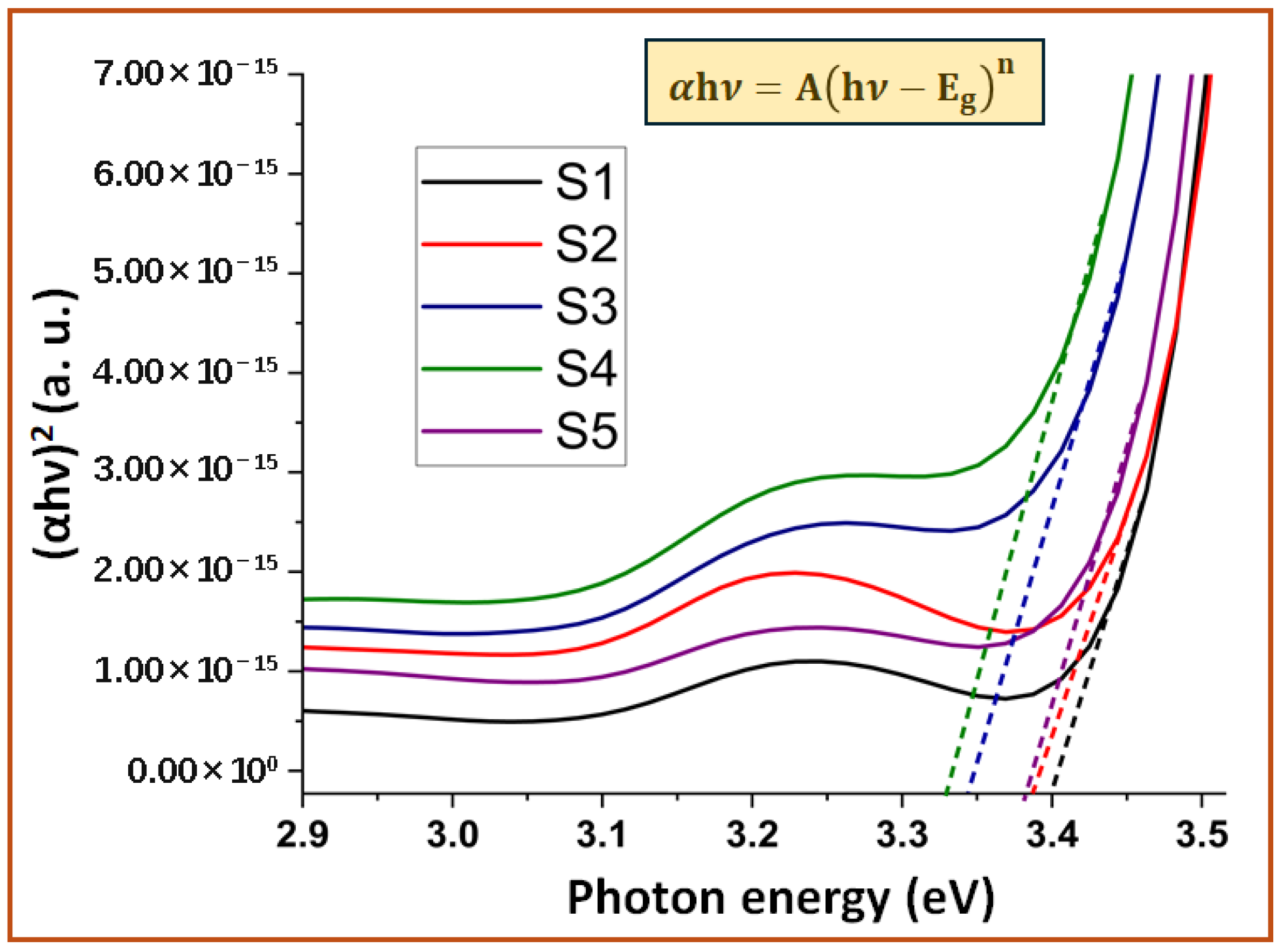
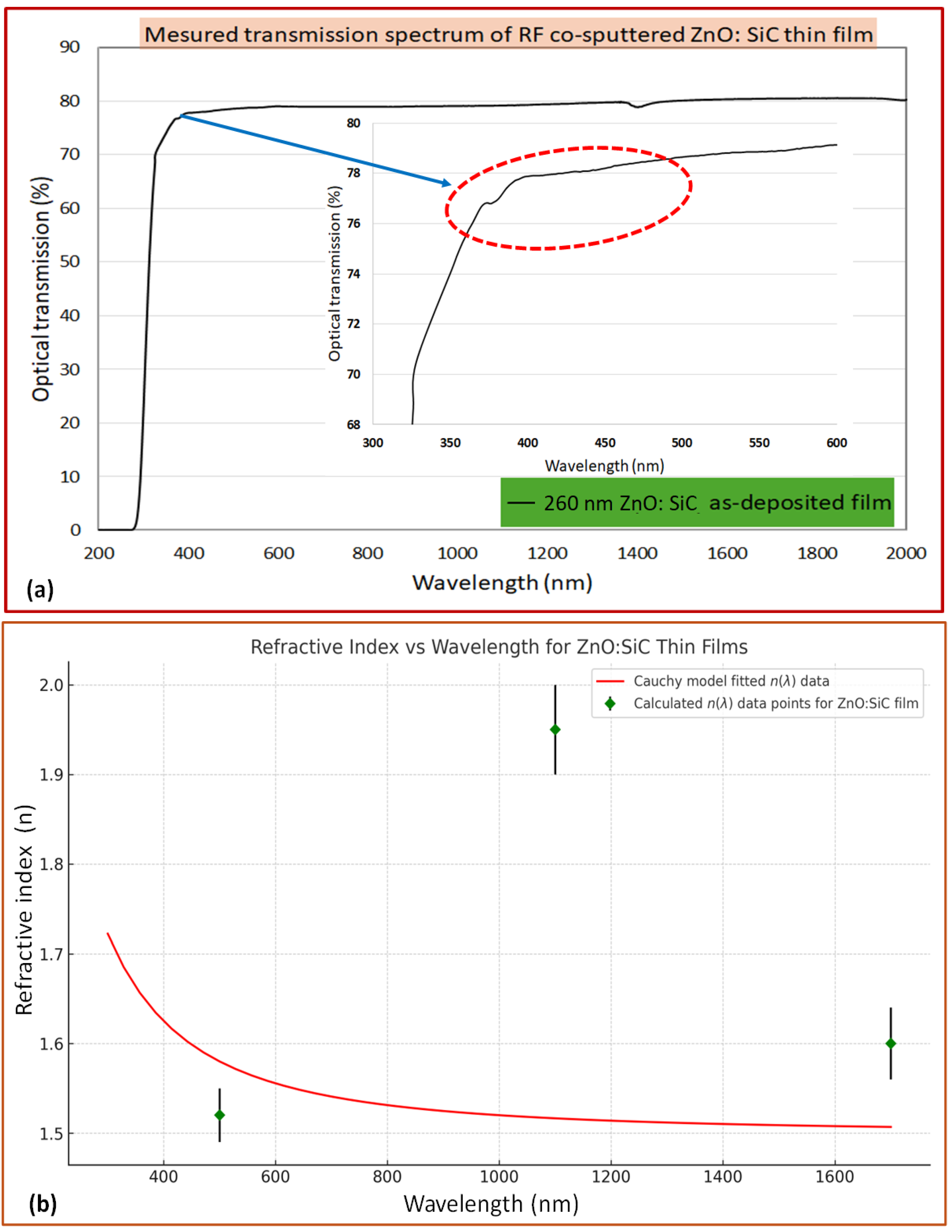

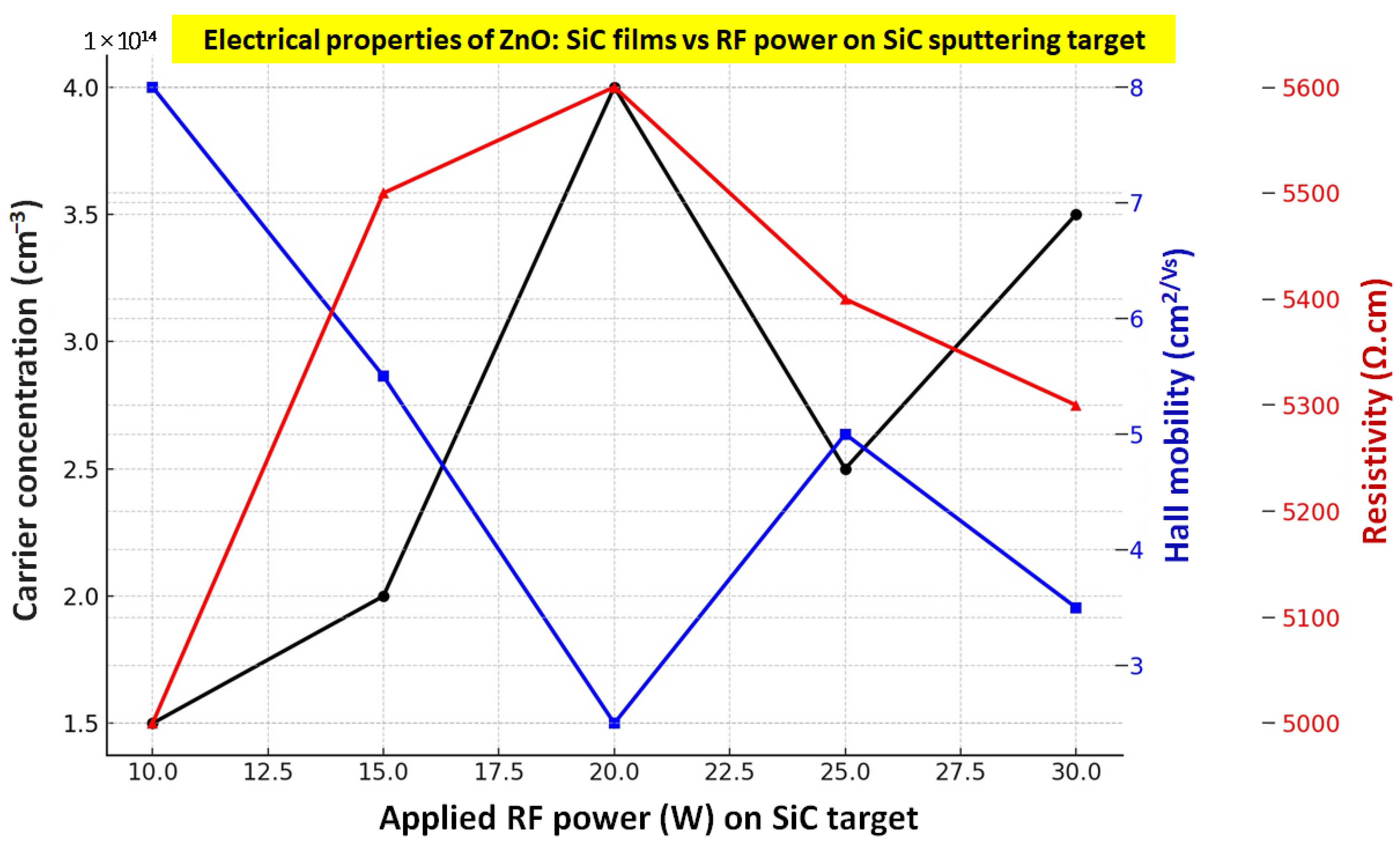
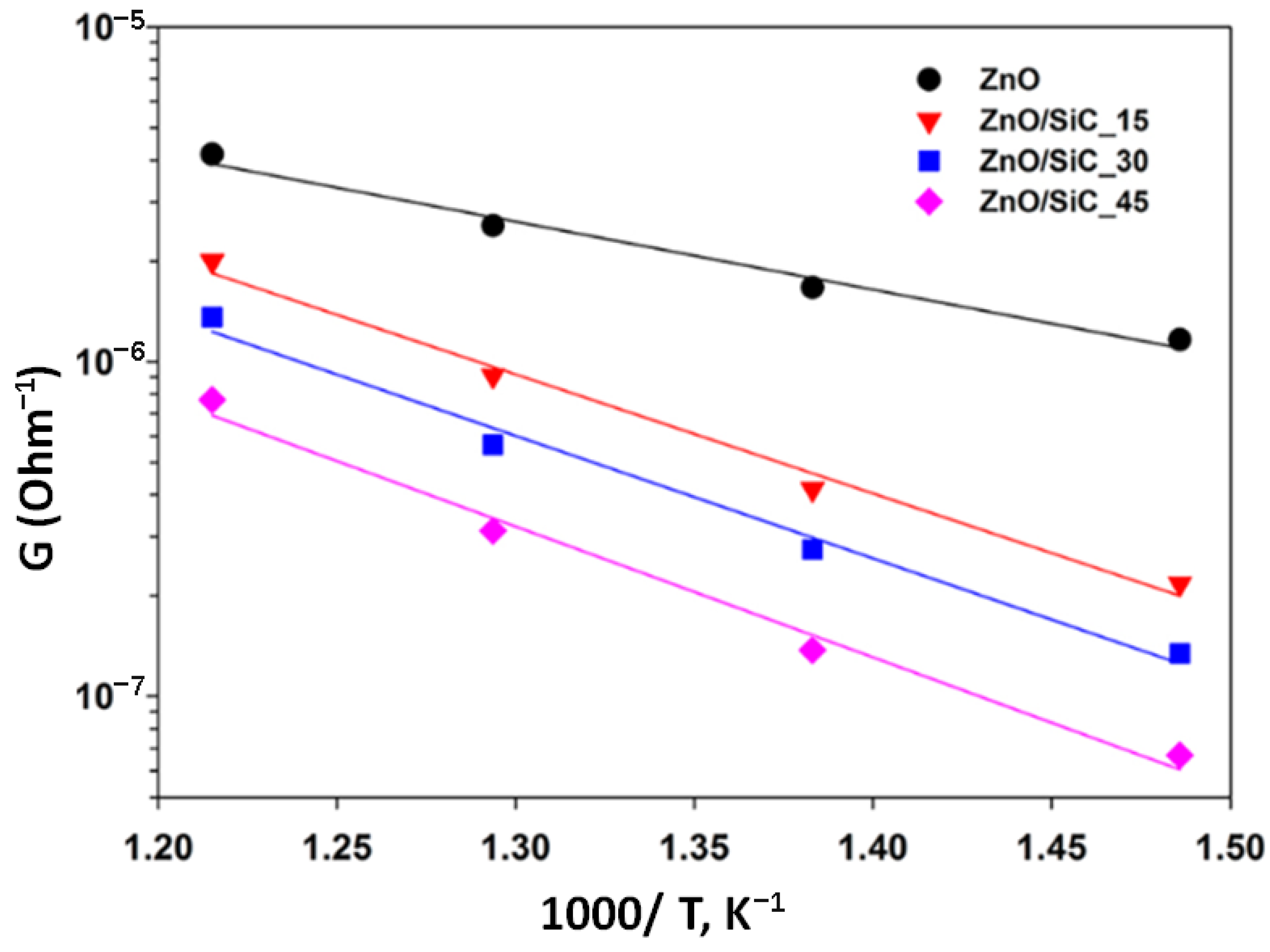
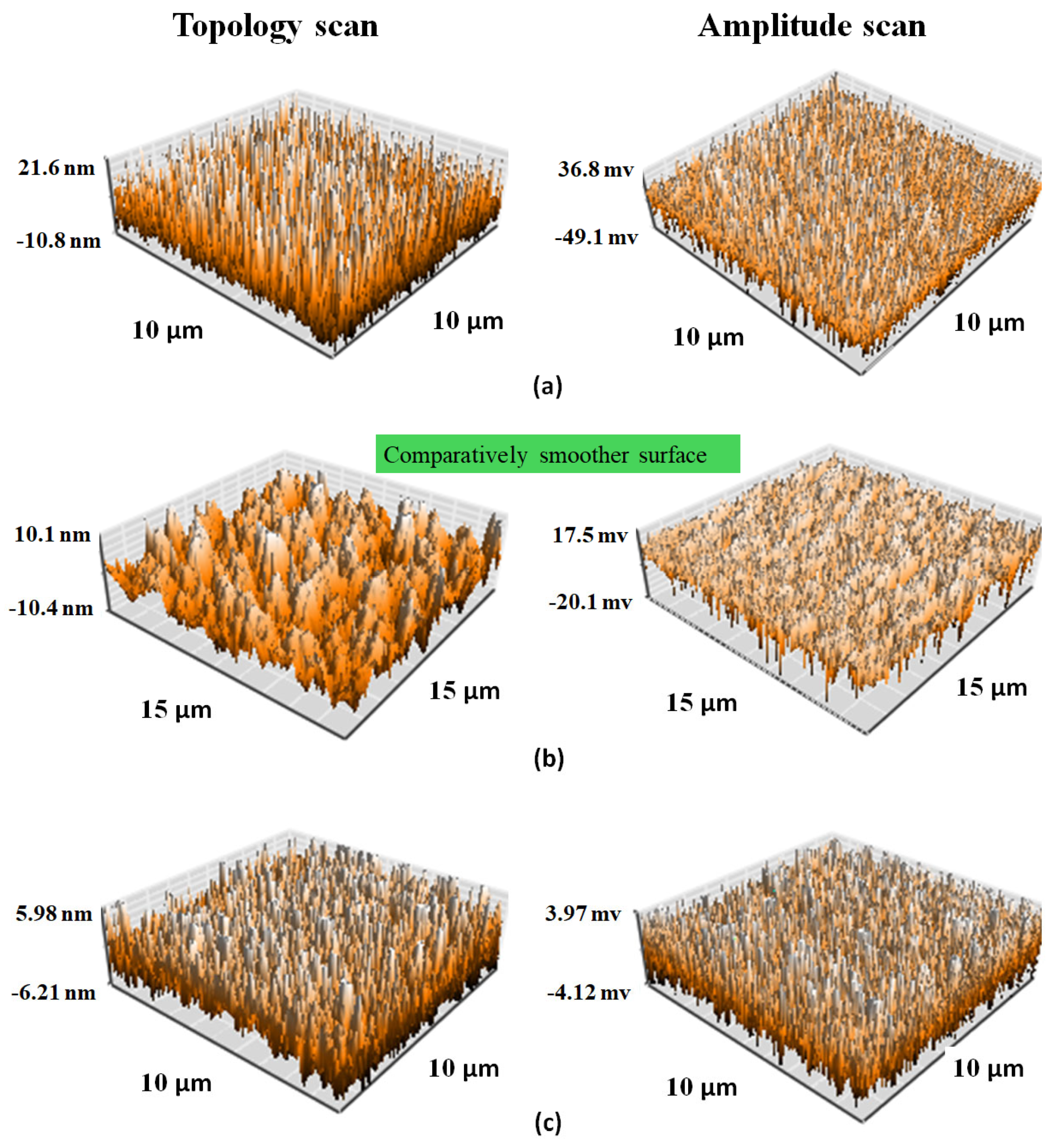
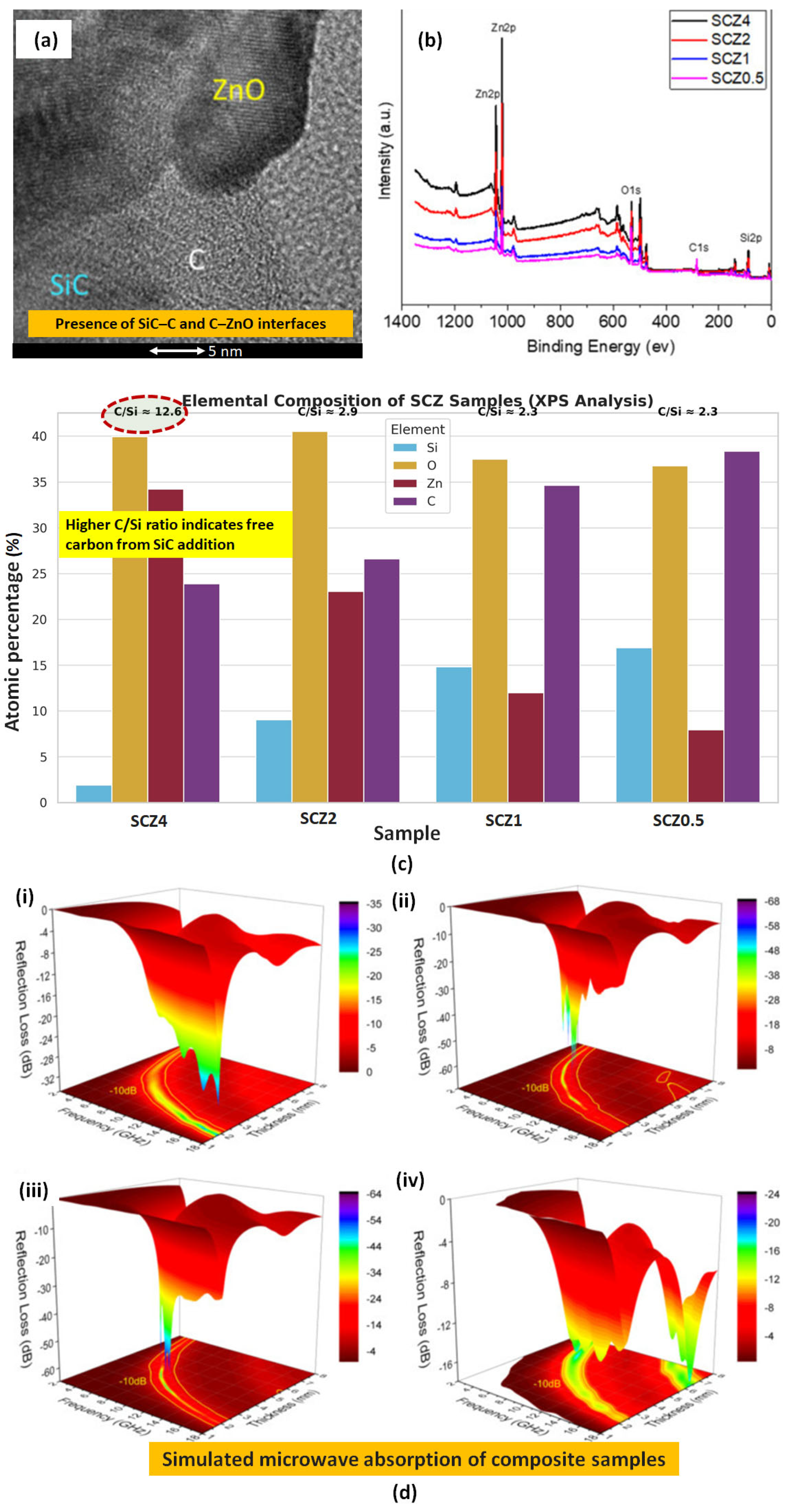

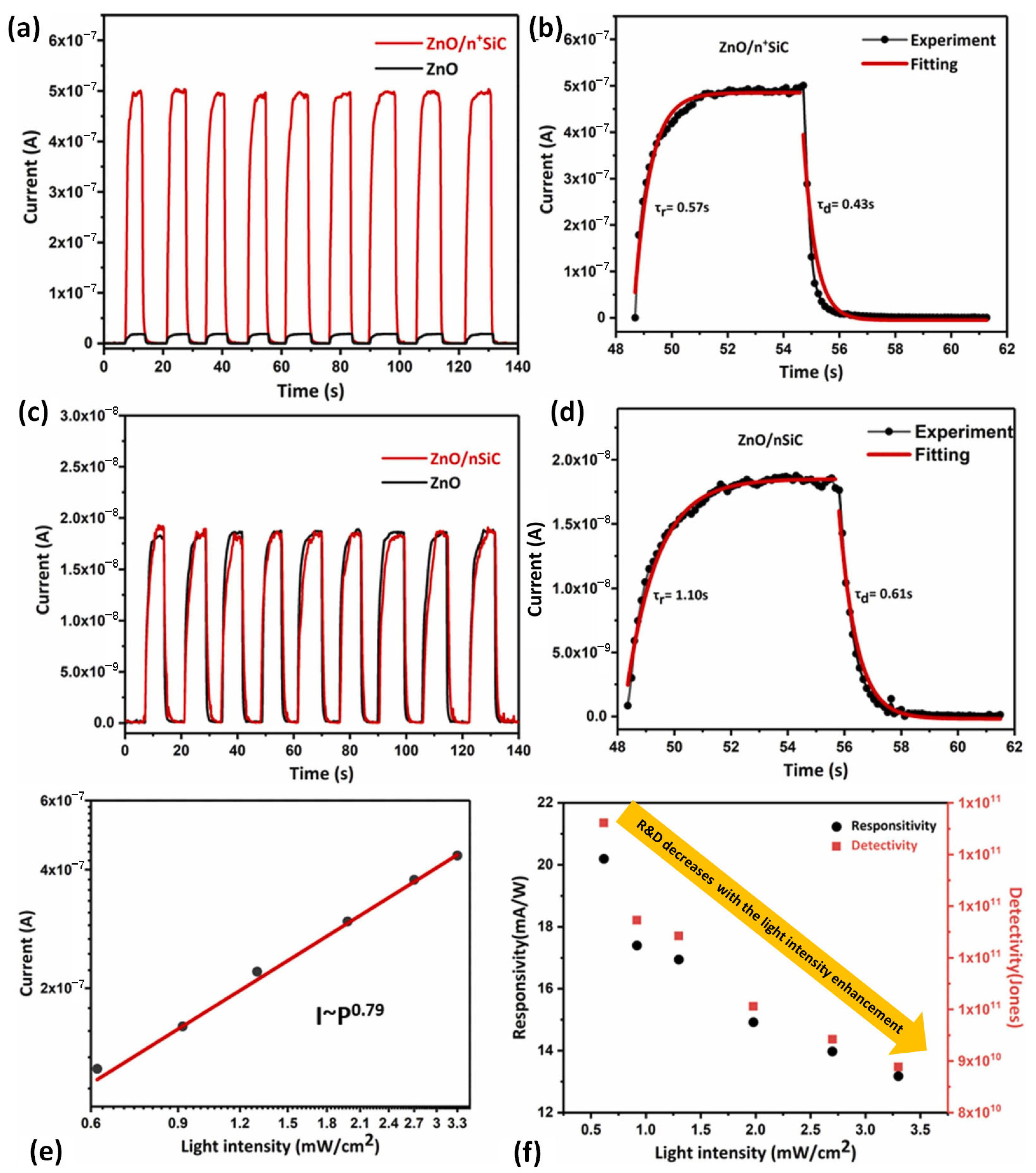
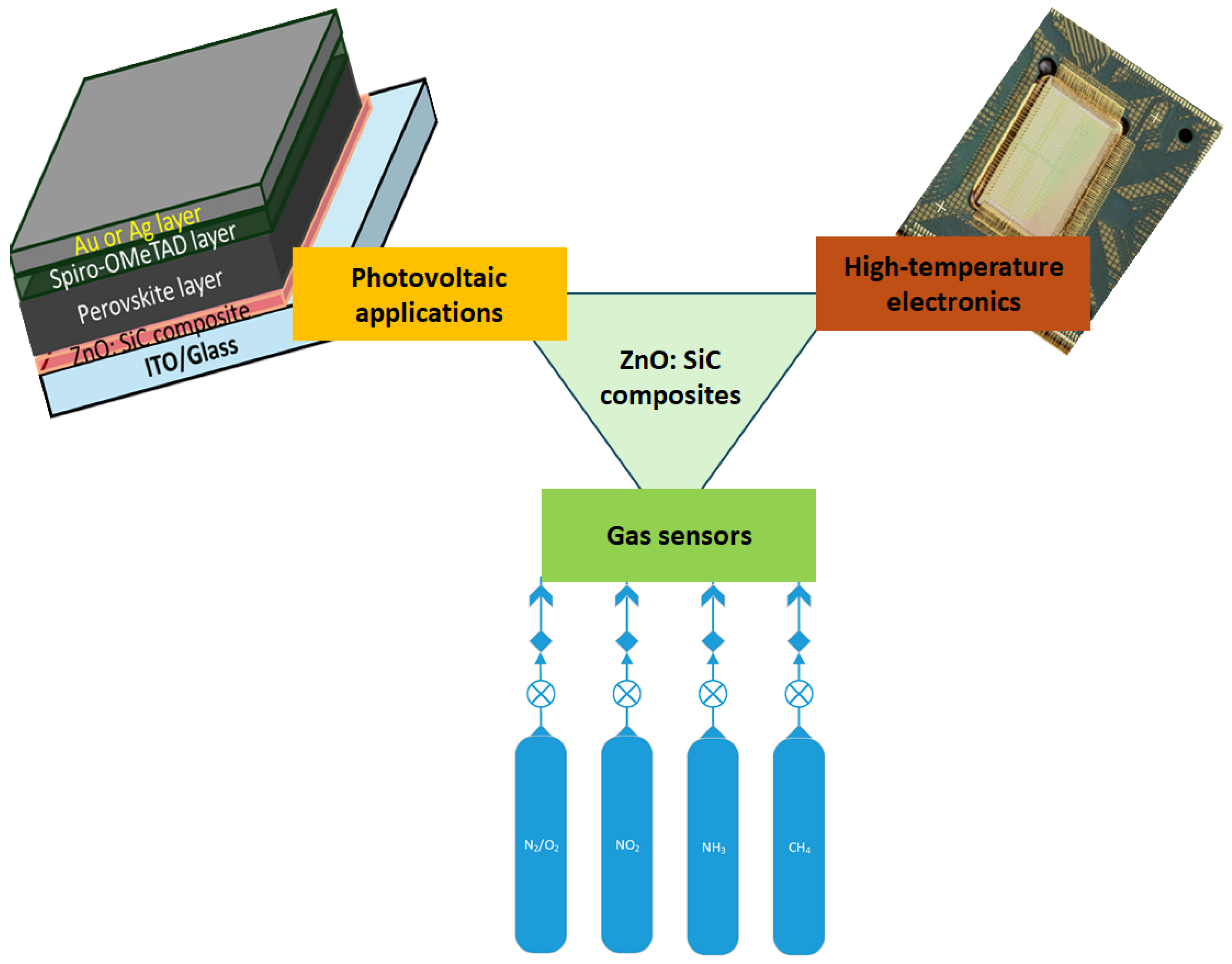
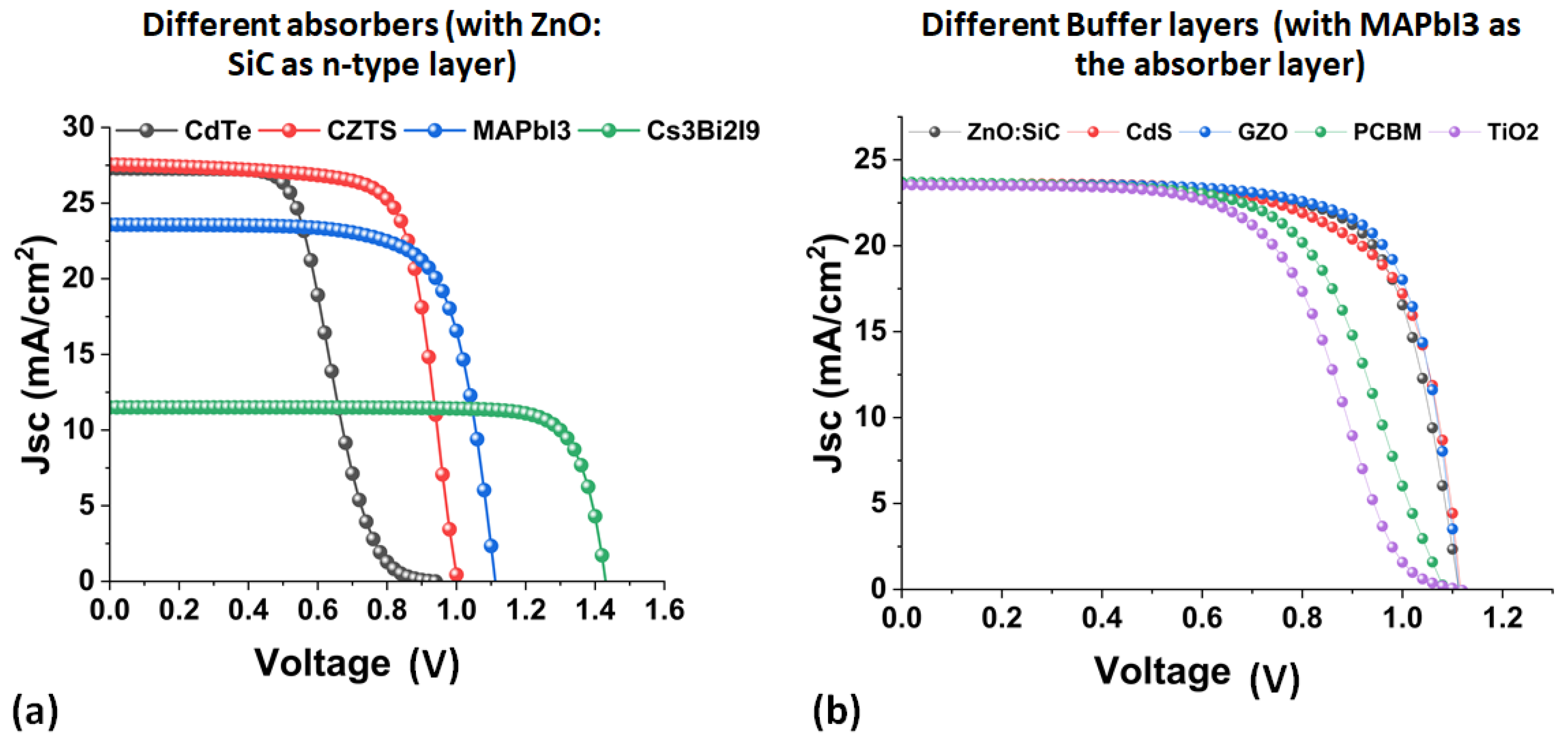
| Method | Key Features | Advantages | Applications |
|---|---|---|---|
| Sol–Gel Method | Solution-based precursor transformation | Low-cost and scalable High purity and composition control | Coatings, nanoparticles, porous films |
| Chemical Vapor Deposition (CVD) | Gas-phase deposition at high temperature | Uniform and high-density films Precise thickness control | Semiconductor, optoelectronics |
| Mechanical Milling | High-energy ball milling of ZnO and SiC powders | Simple and cost-effective Enhances mechanical properties | Nanocomposites, strengthened materials |
| Hydrothermal Synthesis | Reaction in high-pressure aqueous solution | Low-temperature growth Controlled nanostructures | Nanorods, photocatalysis, sensors |
| E-Beam and Thermal Evaporation | Vacuum-based thin film deposition using heat/e-beam | High-purity films Precise thickness control | Transparent coatings, microelectronics |
| RF Magnetron Co-Sputtering | Plasma-based thin film deposition | Dense, uniform films Compositionally tunable | Perovskite solar cells, electronics |
Disclaimer/Publisher’s Note: The statements, opinions and data contained in all publications are solely those of the individual author(s) and contributor(s) and not of MDPI and/or the editor(s). MDPI and/or the editor(s) disclaim responsibility for any injury to people or property resulting from any ideas, methods, instructions or products referred to in the content. |
© 2025 by the author. Licensee MDPI, Basel, Switzerland. This article is an open access article distributed under the terms and conditions of the Creative Commons Attribution (CC BY) license (https://creativecommons.org/licenses/by/4.0/).
Share and Cite
Nur-E-Alam, M. A Study on the Multifunctional Properties and Application Perspectives of ZnO/SiC Composite Materials. Inorganics 2025, 13, 235. https://doi.org/10.3390/inorganics13070235
Nur-E-Alam M. A Study on the Multifunctional Properties and Application Perspectives of ZnO/SiC Composite Materials. Inorganics. 2025; 13(7):235. https://doi.org/10.3390/inorganics13070235
Chicago/Turabian StyleNur-E-Alam, Mohammad. 2025. "A Study on the Multifunctional Properties and Application Perspectives of ZnO/SiC Composite Materials" Inorganics 13, no. 7: 235. https://doi.org/10.3390/inorganics13070235
APA StyleNur-E-Alam, M. (2025). A Study on the Multifunctional Properties and Application Perspectives of ZnO/SiC Composite Materials. Inorganics, 13(7), 235. https://doi.org/10.3390/inorganics13070235






